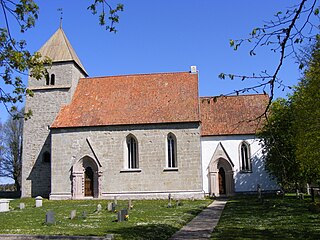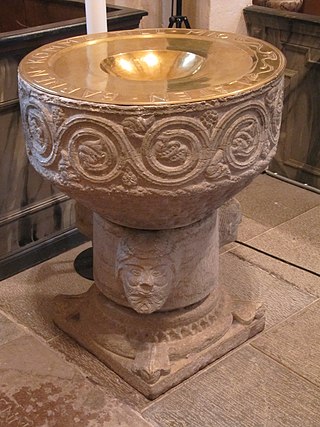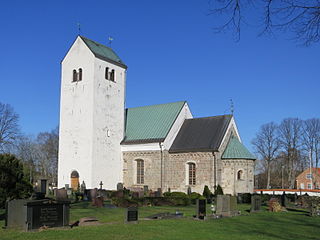
Lund Cathedral is a cathedral of the Lutheran Church of Sweden in Lund, Scania, Sweden. It is the seat of the Bishop of Lund and the main church of the Diocese of Lund. It was built as the Catholic cathedral of the archiepiscopal see of all the Nordic countries, dedicated to Saint Lawrence. It is one of the oldest stone buildings still in use in Sweden.

Valleberga Church is a church in the village of Valleberga, Sweden. It is situated is about 15 miles east of Ystad in Skåne County. It is in the parish of Löderup of the Diocese of Lund.

Sigraf was a Romanesque stone sculptor, working on Gotland. He was mainly active as a sculptor of baptismal fonts, but also of reliquaries, carved pillars and reliefs. He was the most productive of several early medieval stone sculptors making baptismal fonts on Gotland.
Hegvald was a Romanesque stone sculptor of baptismal fonts, working on Gotland.
Byzantios is the notname of a Romanesque stone sculptor or workshop, working on Gotland in present-day Sweden during the last quarter of the 12th century. Byzantios was the first of a series of Romanesque stone sculpture workshops active on Gotland. Around a dozen decorated baptismal fonts from this time are so similar in style and execution that art historians have assumed they have the same origin. The artist has thus been labelled Byzantios. However, they may also have been made by a workshop and not by a single individual. Likewise, the origins and precise artistic roots of Byzantios are not known, but there is a general agreement on that the art of Byzantios show influences from Byzantine art of the period; hence the notname.

Bro Church is a medieval era Lutheran church at Bro on the Swedish island Gotland. Situated on what was possibly a pre-Christian sacred site, the presently visible church was built during the 13th century. Stylistically, its architecture shows a mix of Romanesque and Gothic elements. It still contains some medieval furnishings, including a baptismal font by Sigraf, and murals. The church belongs to the Väskinde parish in the Diocese of Visby of the Church of Sweden.

Grötlingbo Church is a medieval church in Grötlingbo on the Swedish island Gotland. The stately Gothic church contains elements of a Romanesque frieze, incorporated from an earlier church building on the same site. Görtlingbo Church lies within the Diocese of Visby.

Hablingbo Church is a medieval church in Hablingbo on the Swedish island of Gotland. It is one of the largest churches on Gotland, and dating largely from the 14th century, although the current church building was preceded by a stave church. The stone portals of the church are comparatively richly decorated. It is used by the Church of Sweden and part of the Diocese of Visby.

Tingstäde Church is a medieval church on the Swedish island of Gotland, in the Diocese of Visby. Its present appearance dates largely from the 13th and 14th centuries.

Alva Church is a medieval church in Alva on the Swedish island of Gotland. The oldest parts of the church date from the late 12th century; with the halted construction of the tower about a century later, building activity ceased. The church contains medieval murals as well as a number of medieval furnishings and pieces of art. It lies in the Diocese of Visby of the Church of Sweden.

Othelric was a Romanesque stone sculptor, working in Västergötland, present-day Sweden.

Fardhem Church is a medieval church in Fardhem on the Swedish island of Gotland. The present-day church may have been preceded by a stave church; the current church is one of the most well-preserved Romanesque churches on Gotland, built in stages from the 12th to 13th century. It belongs to the Church of Sweden and lies in the Diocese of Visby.

Östra Hoby Church is a medieval Lutheran church built in the Romanesque style. Located 4 km east of Borrby in Skåne County in southern Sweden, it belongs to the Diocese of Lund. The church is noted for its murals and for its sculpted baptismal font.

Vall Church is a medieval church on the Swedish island of Gotland. The largely Romanesque church dates from the 13th century. It belongs to the Diocese of Visby.

Calcarius was an artist working in late Romanesque style on Gotland.

Vinslöv Church is a medieval church in Vinslöv, Scania, Sweden. It belongs to the Church of Sweden. The church contains some of the earliest church murals in Sweden, possibly made by an artist from Lombardy.

Vä Church, sometimes also called Saint Mary's Church in Vä is a well-preserved Romanesque church in Vä, in the southern Swedish province of Scania. It belongs to the Church of Sweden and is a listed building. It was built in the early 12th century, at a time when Scania was part of Denmark. The building was commissioned by a member of the Danish royal family, probably Queen Margaret Fredkulla. The church originally consisted of a nave, a chancel with an apse and two western towers. Quite soon after being finished, it was donated to Premonstratensian monks who used it as the church of their monastery until 1213. It simultaneously functioned as the parish church of Vä. At the end of the Middle Ages, a third tower was built, and in 1593 the building was enlarged. At the beginning of the 19th century, the western towers were demolished. A major restoration was carried out in the 1960s.

Östra Herrestad Church is a medieval church in Östra Herrestad, Simrishamn Municipality, Sweden. It belongs to a group of Romanesque churches built by Carl stenmästare, a master stone mason educated at the building site of Lund Cathedral. The church is richly decorated with 16th-century murals inside.

Löderup Church is a medieval church in Löderup, Ystad Municipality, in the province of Skåne, Sweden. Dating from the 12th century, it has subsequently been expanded and rebuilt, not least under the guidance of architect Carl Georg Brunius in the 1860s. The church contains several old furnishings, including an unusual 12th-century baptismal font.























